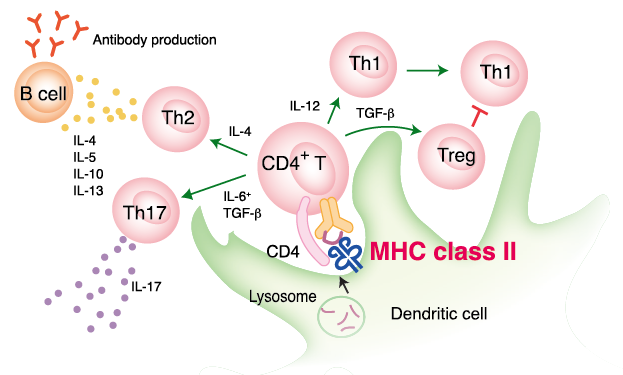- Japan(Japanese / English)
- Global
- MBL TOP
- MBL site search
Mouse MHC class II Tetramer
Experimental autoimmune encephalomyelitis (EAE), a mouse model of multiple sclerosis induced by immunization with MOG35-55 peptide, is a widely used experimental model of autoimmune disease. It has been reported that regulatory T (Treg) cells and Th17 cells are involved in the onset of disease, suggesting that the immune balance of CD4+ T cells is important in EAE pathogenesis.
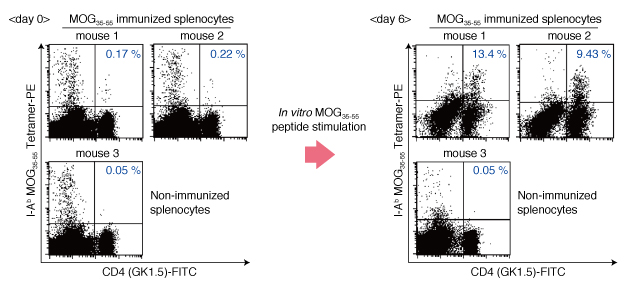
C57BL/6 mice were immunized intraperitoneally twice with 100 nmol of I-Ab-restricted MOG35-55 peptide (MEVGWYRSPFSRVVHLYRNGK, Code No. TS-M704-P) and 10 µg cholera toxin (Previous Code No. RK-01-511) in complete Freund's adjuvant. Eleven days later, splenocytes were isolated and stained with I-Ab MOG35-55 Tetramer-PE (Code No. TS-M704-1; Day 0). An aliquot of splenocytes was stimulated with 10 µg/mL MOG35-55 peptide for 6 days in vitro and then stained with MHC class II Tetramer (Day 6). In vitro stimulation of with I-Ab MOG35-55 resulted in increased tetramer-positive CD4+ T cells from immunized (mouse 1 and 2), but not naïve (mouse 3), mice.
OVA is a model antigen commonly used to study immune responses in mice. OT-II transgenic mice express TCR specific for OVA323-339 epitope (ISQAVHAAHAEINEAGR) in the context of I-Ab and serve as an important tool to study differentiation and activation of CD4 T cells. I-Ab OVA323-339 Tetramer (Code No. TS-M710-1) can be used to monitor antigen-specific CD4 T cell responses in OT-II mice and in various experimental systems using OT-II cells for adoptive transfer.
References:
1) Barnden MJ, et al., Immunol Cell Biol. 76: 34−40 (1998)
2) Moon JJ, et al., Immunity. 27: 203−213 (2007)
3) Landais E, et al., J Immunol. 183: 7949−7957 (2009)
Figure 1-1: I-Ab OVA323-339 tetramer staining of freshly isolated OT-II splenocytes
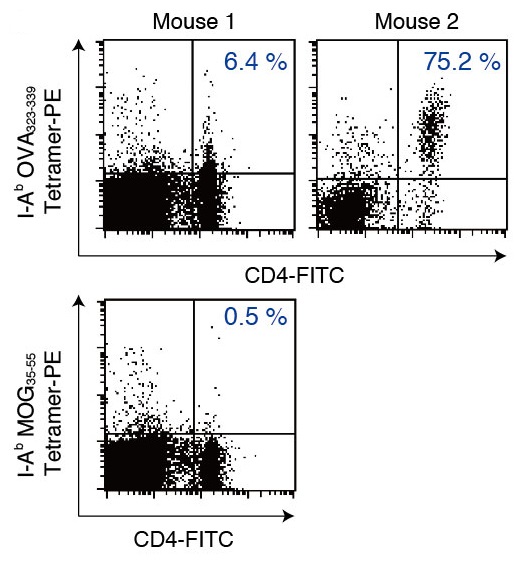
Figure 1-2: I-Ab OVA323-339 Tetramer staining of peptide-stimulated OT-II splenocytes (Day 6)
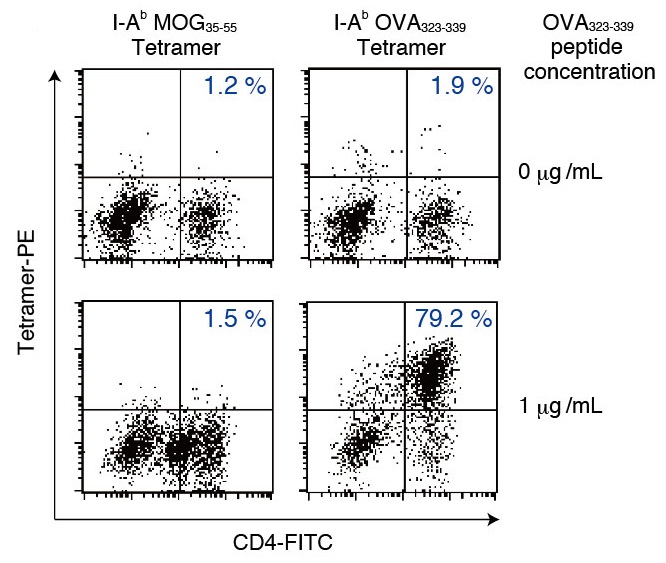
Reactivity of I-Ab OVA323-339 Tetramer reagent was assessed using freshly isolated spleen cells from OT-II mice. The majority of CD4 T cells were tetramer positive in mouse 2, but not in mouse 1 (Figure 1-1). In vitro stimulation with specific peptide significantly increased the number of tetramer positive cells (Figure 1-2).
Figure 2: I-Ab OVA323-339 Tetramer staining of splenocytes from peptide-immunized mice
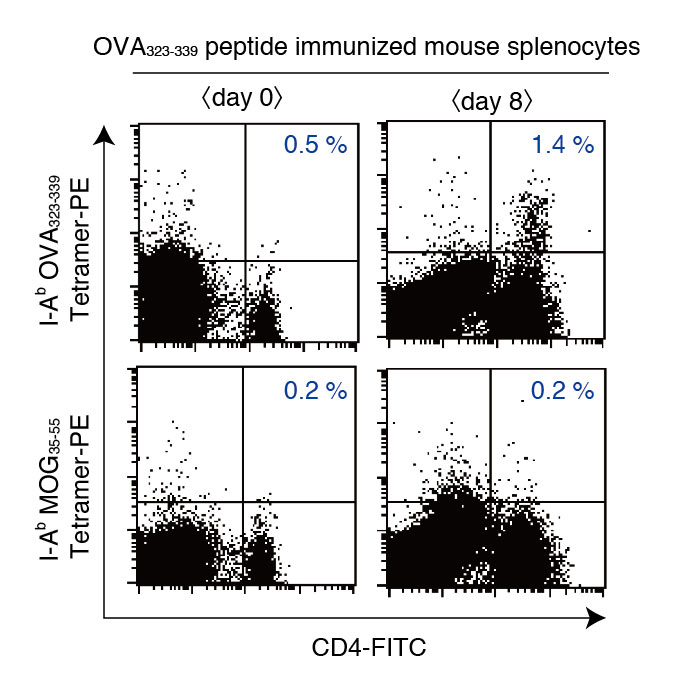 OVA-specific CD4 T cells can also be induced in wild-type mice. C57BL/6 mice were immunized twice IP with a mixture of 100 nmol of OVA323-339 peptide (Code No. TS-M703-P(Discontinued)) and 10 µg of cholera toxin emulsified with adjuvant. After 11 days, spleen cells were harvested and cultured with a final concentration of 1 µg/mL OVA323-339 peptide for 8 days. Cells were tested on days 0 and 8 of culture for OVA tetramer reactivity. In mice immunized with OVA323-339 peptide, induction of specific T cells by in vitro peptide stimulation was confirmed using I-Ab OVA323-339 Tetramer (Code No. TS-M710-1). I-Ab MOG35-55
OVA-specific CD4 T cells can also be induced in wild-type mice. C57BL/6 mice were immunized twice IP with a mixture of 100 nmol of OVA323-339 peptide (Code No. TS-M703-P(Discontinued)) and 10 µg of cholera toxin emulsified with adjuvant. After 11 days, spleen cells were harvested and cultured with a final concentration of 1 µg/mL OVA323-339 peptide for 8 days. Cells were tested on days 0 and 8 of culture for OVA tetramer reactivity. In mice immunized with OVA323-339 peptide, induction of specific T cells by in vitro peptide stimulation was confirmed using I-Ab OVA323-339 Tetramer (Code No. TS-M710-1). I-Ab MOG35-55
Tetramer (Code No. TS-M704-1), used as a negative control, showed no specific staining.
Anti-Mouse TCR DO11.10 (clone KJ1.26) is an antibody that binds to the TCR specific for OVA323-339 presented in the context of I-Ad. This antibody can be used to identify OVA323-339-specific CD4 T cells derived from I-Ad mice. OVA323-339 peptide (ISQAVHAAHAEINEAGR, Code No. TS-M703-P(Discontinued)) is often used as a helper peptide for induction of antigen-specific CTL in I-Ad-expressing mice.
■ Flow cytometry with Anti-mouse TCR DO11.10 mAb

I-A alleles of mouse strains
I-A alleles
|
I-Ab
|
I-Ad
|
I-Ak
|
I-As
|
|---|---|---|---|---|
Mouse strains
|
C57BL/-,
BXSB/Mp, 129/- |
BALB/c,
DBA/2 |
C3H/He
|
SJL/J,
B10.S |
Tips for better staining
・ How to use?
・ Staining method
・ Induction of specific CTL
・ FAQ




